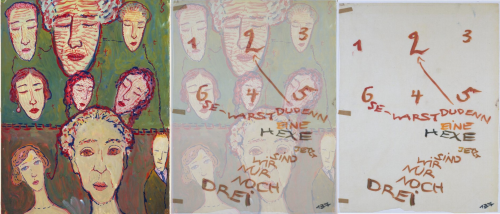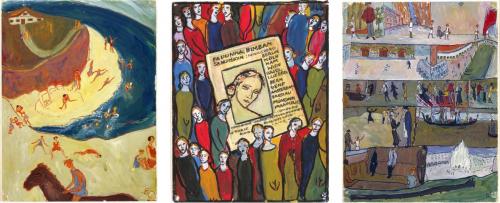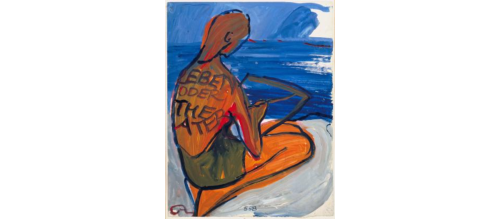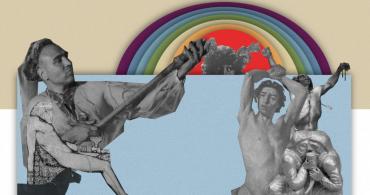Life? Or theater?
2 october, 2020
Throughout the year, Charlotte Salomon (1917-1943) worked with concentration on the creation of “Life? Or theater?“ in the hotel room of La Belle Aurore in the south of France. With an attentive eye and a good memory, the artist was able to retrospectively describe her life and her family in the background of political and social upheavals in Germany. In addition to the artist's personal history, the work, created in the period from 1941 to 1942, immerses the viewer in the disruptive culture of central Europe at the beginning of the 20th century.
«Since I myself needed a year to find out what this strange work is about to me, especially in the first sheets, many of the texts and tunes have been omitted and must — it seems to me — remain shrouded in darkness, like the creation as a whole. CS»
Technical description
"Life? Or theater?" — consists of 769 gouache drawings, numbered and divided into parts: Foreword, Main part and Epilogue. The images are accompanied by explanatory text, which is written in different colors, sizes, direction of letters, emphasizing the composition and guiding the viewer along the sheet with the movement of the text or lines. The story is embedded in the work in several ways. In most cases, this is an accompanying page of tracing paper with text attached to the drawing with adhesive tape, in order to see the image, you must mechanically unfold the tracing paper sheet. In some pictures, text is inserted directly into the picture, while other sheets are composed entirely of text.
In her work, the artist used the main colors of the spectrum — red, yellow and blue, mixing them together to create more complex shades, sometimes adding white, but, interestingly, black paint was not used at all.
In her drawings, Salomon used various compositional techniques — linear and non-linear plot arrangement, dramatic close-ups or scenes reminiscent of a movie storyboard. The narrative style of the work recalls not only the forms of narrative art, but also the more modern comics, which gained popularity in Germany only after the war. In the course of the escalation of events in Charlotte's life, her work turns from graphically drawn scenes, which the viewer observes from the side, into very emotional drawings of human experiences. If in the Prelude the artist draws a plan of the apartment where her family moved with a description of each of the 10 rooms, then the Epilogue is a therapeutic attempt to understand and accept what is happening. The experience of perceiving a piece is very similar to watching a silent film.
Cultural and historical references
Inheriting Wagner's ideas on the unity of the arts, “Life? Or theater?" is a multimedia work, which, in addition to gouache drawings, contains elements of text, music and theater, the artist herself called the work a singspiel. Salomon's broad cultural background can be seen in numerous references to a variety of works ranging from classical painting to emerging cinematography.
Music: Many of the pages show the music for the scene. Salomon mentions the works of Bach, Gluck, Strauss and Schubert, there are also German and Jewish folk songs or National Socialist songs of the Third Reich. Music enhances the emotional component of what is happening and helps to feel the atmosphere. For example, the Christmas holidays were accompanied by a traditional song, the first appearance of one of the main characters, Amadeus Daberlon, is indicated by the Toreador Song from the opera Carmen, and the scene in which Charlotte tries to dissuade her grandmother from suicide is indicated by Beethoven's “Ode to Joy”.
Painting: Charlotte Salomon grew up during the formation of German Expressionism, in 1937 she had the opportunity to visit the exhibition of Degenerate Art, which had a greater influence on the formation of her taste. During this time, she was still attending an art academy, from which she had to leave due to growing anti-Semitic sentiments. The influence of the Die Brücke art group and Edvard Munch is especially noticeable in the emotional tension, color and compositional solutions of her works. In addition to her contemporaries, Salomon was also inspired by the works of classical art, direct quotes can be found to the works of Michelangelo (The Last Judgment), Rembrandt (Anatomy Lessons) and Friedrich (Woman at the Window).
Social premises: Philosophy and the development of psychology in the twentieth century also affects the outlook of the characters in “Life? Or theater? " The feeling of one's own helplessness and loneliness, complemented by pressure from society and the growing authoritarian political movement, is illustrated by the story of Charlotte's grandmother, Mrs. Knarre (Marianne Grunwald). The story takes place in the background, but clearly characterizes the despair and hopelessness that gripped many people at that time. “And my husband — he loves me not. And my child — needs me not. Why, oh why, am I living”. Almost all of her relatives, including both daughters, suffered from depression and eventually resorted to suicide, an unhappy marriage, anti-Semitic attitudes of society weakened Mrs. Knarre and many others. The number of suicides in Germany in the 1920s and 1930s, especially among Jewish women, was very high, but often relatives kept silent about the cause of sudden death, in the name of preserving the face of the family in front of society. In particular, it was hidden from Charlotte that 8 people from her family had committed suicide, including her mother. So, Paula Salomon for some time censored from the public one of the most problematic drawings, where Charlotte's grandfather tells her to kill herself.¹

In the work, Charlotte Salomon devotes quite a lot of attention to Amadeus Daberlon's (Alfred Wolfson) reflections on life, death and the nature of art. Daberlon uses the myth of Orpheus descending into the underworld as an analogy to the fact that there is a connection between death, soul and human artistic abilities. In order to maximize his abilities, a person must not only love life, but also learn and overcome the fear of death — having cognized the unconscious (the underworld), you can achieve a new form of creativity. In real life, Wolfson wrote the book Orpheus or The Path to the Mask, several pages of which are sketched in Life? Or theater? " At the end of the story, Charlotte recalls Daberlon's ideas and his belief in her artistic ability and, despite all the oppressive circumstances, decides to continue living. “And she found herself facing the question of whether to commit suicide or to undertake something quite insanely extraordinary. And from that came: The Life or the Theatre?”.
First exhibitions
After leaving Berlin in 1938, Charlotte Salomon lived with her grandparents in the south of France at the villa of Ottilie Moore, the daughter of a wealthy American businessman, who hosted refugees in her home. Ottilie liked Charlotte's drawings, she bought several works and in every possible way supported her work by providing financial support for the acquisition of materials. In 1941, Moore, along with ten children (some of them were Jews) left for America, Charlotte remained in France. After finishing work on “Life? Or theater?”, Sensing the approaching danger, she handed the packaged work to her friends, where Ottilia Moore was designated the final recipient. In 1943, at the age of 26, Charlotte Salomon was arrested and sent to Auschwitz, where she was immediately killed.
After the end of the war, Albert and Paula Salomon, Charlotte's parents who survived the war in the Danish province, took the package from Ottilia Moore and brought it with them to Amsterdam. Thanks to the lobbying of her parents in the 1960s, the first exhibitions “Life? Or theater?" took place. The curators did not immediately pay attention to the numbering and the order in which the work was handed over to them but chose several of the most expressive drawings in their opinion. In 1971, Albert handed over “Life? Or theater?" to the Museum of Jewish History in Amsterdam. Here for the first time, through the works of the curator Eva Ornstein-van Slooten and her assistant, they reproduced the integrity of the work and its supposed sequence as we know it now. Also, the curator found a note in which Charlotte Salomon asks to keep the order of the pages exactly in the order in which they were transmitted, since not all pages are numbered. Unfortunately, the original sequence of the work was forever lost due to the illiterate organization of the first exhibitions.
“...she had to vanish for a time from the human surface and make every sacrifice to create her world anew out of the depths”.





